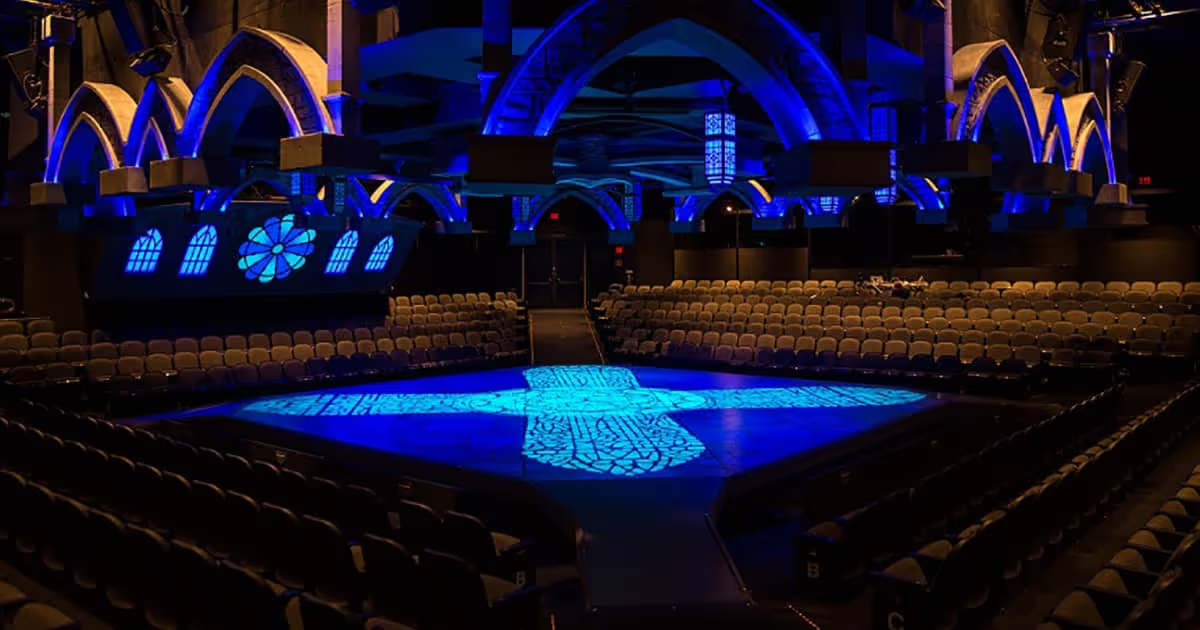Evita
In the press materials for Marriott Theatre's production of"Evita," director/choreographer Alex Sanchez evinces a passion not just for the Andrew Lloyd Webber rock opera, but also for the history that informs the story. That passion translates into a scorching rendition of the show that skillfully blends the personal with the political and hagiography with history.
Thomas Ryan's set is minimal, keeping the stage open to accommodate the large ensemble much of the time. All around the ceiling of the stage in the round, though, Ryan creates the sense that this world is densely inhabited -- and rarely, if ever, private -- through an array of mismatched window shutters. The haphazard arrangement of the shutters, a range of lighting elements flown in and out and sections of the stage that raise and lower all signal shifts in the scene without jeopardizing the driving pace.
Jesse Klug's lighting design makes free use of gobos and saturated color to heighten the drama and impart the necessary sense of scale to many of the crowd scenes. Nancy Missimi's costumes both honor Eva's iconic look and, in outfitting the ensemble, create an effective visual shorthand, rich with information about class and identity and lending tremendous depth to this rendition.
Missimi's skill underpins the director's careful emphasis of the ensemble. Departing from the scripted opening in a movie theater, where the film is interrupted to announce Evita's death, Sanchez begins in a private home with a family of "des camisados" gathered around the radio. This choice trades a moment that would usually convey the nation-wide impact of the news for more intimate, and arguably more authentic grief.
Similarly effective is the decision to expand and extend the role of the ensemble in the middle of some of the showier numbers. Early on in "Buenos Aires," Sanchez choreographs violent encounters between the military and the bourgeois, the workers, and both groups that would oppress them. During "I'd Be Surprisingly Good for You," the calculated passion between Eva and Perón takes place in the raised center of the stage with the whole world looking on.
Each of these mindful additions is further underscored by the outstanding vocal arrangements for the ensemble (Music Direction by Ryan T. Nelson) and the adept, electric guitar-infused orchestral reductions (David Siegel). If the end result doesn't quite absolve the production from well-earned criticism for failing to cast actors of color for the primary roles, it at least speaks to the director's commitment to the repercussions of one woman's ambitions on a struggling nation.
Sanchez is especially fortunate in his performers. Austin Lesch's smooth tenor makes for a Che so charming that every time his fury erupts, its snarling power is undiminished. Hannah Corneau navigates the vocal challenges of Evita damned near perfectly and infuses the role with a quieter, more understated power than is usual. If there's any flaw in Sanchez's approach, it might be that holds off capitalizing on the chemistry between these two performers all the way up to "Waltz for Eva and Che."
Larry Adams is a capable Perón. He sells the immediate attraction to Eva well, and his voice is well-suited to the role, though he struggles dramatically in establishing how, exactly, El Presidente feels about unstoppable phenomenon his wife becomes just when it's his star that ought to be rising.
The ensemble rises to every occasion throughout the show. Especially noteworthy are the male performances as the military elite. Sanchez calls on Missimi to craft the most ridiculous costumes possible, then doubles down on the visual by choreographing them as tantrum-throwing children. The effect is hilarious, yet unflinching, as it makes obvious the fact that there are no good choices for either the characters or the millions affected by however the "art of the possible" plays out.











